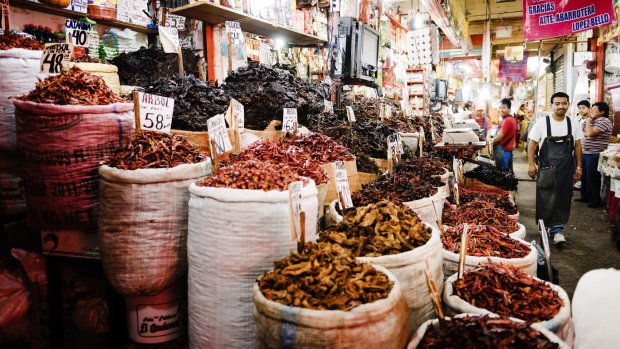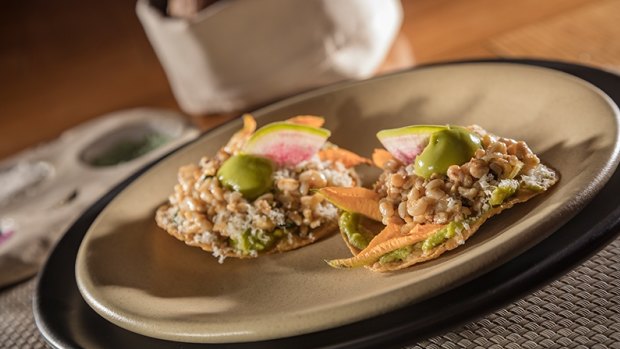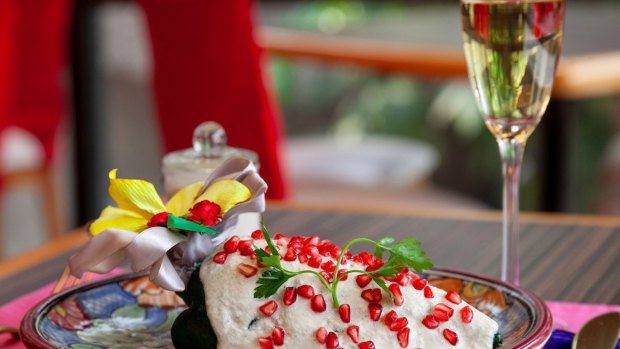This was published 4 years ago
Best Mexican foods: Beyond tacos, 11 of the best things to eat in Mexico City
By Rachel Olding

A stall specialising in dried chillies at the Mercado de la Merced in Mexico City. Credit: Getty
Adrian Becerril, a Mexico City local who has worked as a chef in restaurants around the world, jokes that his fellow countrymen are "like hobbits".
"We're always thinking about the next meal," Becerril says as he takes a small tour group through the city's biggest market, Mercado La Merced. "We Mexicans believe that life is scheduled around food."
Eating in Mexico City is an overwhelming, kaleidoscopic, mind-altering and ridiculously affordable experience. Steeped in rich food history, the city is a melting pot of 32 Mexican states, each with its own traditions and foods, home to ingredients available nowhere else in the world. Tacos are the most well-known bedrock of dining in Mexico City and locals, known as chilangos, are extraordinarily passionate about the act of wrapping a maize tortilla around food.

A tostada topped with ant larvae (known as escamoles in Mexico),
But finding a good al pastor taco in the capital is not hard. They're everywhere, from footpath grills to late-night auto-repair shops to $200-a-head restaurants. It's trying everything else in this chaotic city that can be daunting. Here's a non-exhaustive guide to best foods and drinks to try in Mexico City that aren't tacos.
TAMAL Y ATOLE
Lunch is the main event in most Mexicans' day but breakfast is hardly neglected. Chilangos usually grab a pan dulce and coffee (Mexico claims to have more pastry varieties than France, as the multi-level Pasteleria Ideal or charming Panaderia Rosetta attest), sit down for a hearty meal such as chilaquiles (El Cardenal is a city fave) or wolf a tamale from a street vendor. Tamales are corn dough patties, stuffed with sweet or savoury fillings, steamed in a corn husk or banana leaf. Look for the big steel drums on street corners, often accompanied by atole, a thick drink made from corn dough, water, sugar and cinnamon. If, by some supernatural feat, that doesn't fill you up, try the Mexico City specialty: a tamale in a bread roll, a carb-bomb known as guajolota or torta de tamal. see pasteleriaideal.com.mx; rosetta.com.mx; restauranteelcardenal.com

Chiles en nogada, a traditional festive dish, served at Azul's three restaurants in Mexico City, Mexico. The dish consists of poblano peppers, stuffed with fruits and meats, covered in walnut cream sauce and pomegranate seeds. It is eaten in Mexico between August and early September only. Credit: Azul Restaurantes
INSECTS
Mexicans eat more than 500 types of bugs, partly a reflection of the resourcefulness that has risen from poverty. At Mercado La Merced, an overwhelming and magnificent place to visit, vendors will plonk a crisp-fried cocopache (a beetle) in your hand to munch on. Street carts sell chapulines (grasshoppers) by the bag, doused in chilli, salt and lime. But if eating bugs by the fistful makes your stomach turn, an upmarket restaurant in the Mexico City neighbourhood of Polanco might be a safer environment in which to dabble. The aptly-named Chapulin serves grasshopper tacos and delicious tostadas heaped with escamoles (ant larvae, often called the Mexican caviar), creamy avocado and pumpkin blossom. Limosneros, a chic spot in the city centre, stuffs zucchini flowers with cocopaches like a pretty Mexican ravioli. See limosneros.com.mx; chapulin.rest
CHILES EN NOGADA
Visit Mexico City between August and early September and every restaurant will be spruiking their chiles en nogada, a festive dish made when pomegranates are in season and when national independence celebrations begin. The dish is not for everyone. It's a sweet-savoury mix of room-temperature poblano chillies stuffed with meats, fruits, spices and herbs, topped with walnut cream sauce and pomegranate seeds. The combination of green chilles, white sauce and red seeds is thought to mimic the Mexican flag and its origins can be traced to nearby Puebla, where locals made it to entertain future emperor Agustin de Ituribide after signing the Treaty of Cordoba. The offerings at two restaurants stand out: Azul in Condesa and Nicos, a must-visit 60-year-old gem on the city outskirts. See azul.rest; nicosmexico.mx
CHAMORRO
Even for city workers, lunch is a leisurely affair in Mexico. It seems everyone in the Doctores neighbourhood, just outside the city's tourist areas, flocks to El Sella for the house specialty chamorro. Translating as calf in Spanish, the chamorro is a leg of melt-in-your-mouth pork that practically falls off the bone and into a guac-filled tortilla itself. Order a cold cuba libre or modelo, put your afternoon plans on hold and enjoy lunch like a chilango. Salon Rios, a modern cantina in trendy Juarez, also does a great chamorro. See barelsella.com.mx; salonrios.mx
PAMBAZO
If a day of sightseeing must be fuelled on the go, look for Mexico City's famous orange-hued sandwich. Pambazo is made with a particular type of white bread, dipped and fried in guajillo pepper sauce, stuffed with potatoes and chorizo, and topped with lettuce, cheese, and cream. Not all pambazo were created equally though; finding a good one can be tough. Several locals recommend the pambazo stall at Saturday's Avenida Sullivan market or the always-busy stall outside Hidalgo metro station, near Parque Alameda, run by three sisters.
MOLE
Mole, the incredibly complex traditional Mexican sauce, is "chaos", the city's most famous chef, Enrique Olvera, said in an episode of Netflix's Chef's Table. Each creator will refine his own mix of dozens of ingredients: chillies, fruits, spices, herbs, garlic, seeds, cinnamon, tomatoes, nuts and, often, chocolate. "There's ingredients from almost everywhere in the world and when you put them together, it makes sense. They become Mexican for some magical reason. And I think that summarises Mexico," added Olvera, who serves a 1800-day aged, 100-ingredient mole at his restaurant Pujol. At La Merced, vendors display buckets of just-add-water mole pastes and powders. See pujol.com.mx
QUESADILLA
What makes Mexico City quesadillas so special is the simplicity of ingredients. Chilangos don't use cheese to fuse the tortillas (order one con queso if want cheese), instead filling them with zucchini flowers, a cheap grocery staple in Mexico, or huitlacoche, a fungus that grows on corn and is little-known outside Mexico. Corn is the heart and soul of Mexican cuisine so good maize is essential, too. "In every single tour I try to show visitors just how important corn is for our culture and our daily life, and how versatile it can be," says Anais Martinez, a local food guide and blogger at The Curious Mexican. She loves Cal y Maiz, one of a new wave of modern tortillerias bringing back the traditional nixtamal technique of maize preparation and using some of Mexico's hundreds of heirloom corn varieties, which have been slowly subsumed by big-scale GMO farming. Their quesadilla will blow your mind. For novelty factor, Los Machetes de Amparito serves delicious 70-centimetre machete-shaped quesadillas that cost about $5. Just be prepared to wait. See thecuriousmexican.com
JUGO VERDE
The Lycra-wearing brunch crowd in Bondi and Toorak didn't invent the green juice. Mexicans have been sipping their vegies for much longer. Ask for a jugo verde at any of the ubiquitous streetside juice stands and you'll get a delicious combo of parsley, celery, orange or grapefruit, pineapple, nopal (flat cactus) and xoconostle (a prickly pear that grows on nopal). It'll cure any hangover, taco overload or travel fatigue for less than a dollar.
CHURROS
A trip to the original Churreria El Moro for fresh cinnamon churros is a Mexico City pilgrimage. The chain's first cafe, in the historic centre, was opened in 1935 by a Spanish migrant who had opened a small churro cart in Zocalo two years earlier upon seeing that no churros were being sold in Mexico. Its several branches throughout the city are known for their blue tiles, hot chocolate and circular batches of long, thin churros made in the window. But the original cafe has historic photos and a 24-hour stream of hungry businessmen, families, street dwellers and artists. See elmoro.mx
CAMOTES
"No matter where you are in Mexico City, as the night starts, you will hear a steam whistle," Enrique Olvera writes in his book Tu Casa Mi Casa. The high-pitched whistle of a camote cart is not only one of Mexico City's most iconic sounds, it indicates that one of its oldest street foods is nearby. The carts sell native sweet potatoes and plantains, roasted over charcoal inside a steam engine and doused in condensed milk, jam or cinnamon. They're smoky, mushy, super sweet and kept warm by wood-powered steam that, when released, creates the unmistakable whistle sound. It's Mexico's version of the ice-cream truck.
MICHELADA
Few things feel as authentically Mexican as strolling through Lagunilla flea market on a Sunday then merging into the heaving Tepito market, past vintage furniture stalls, bootleg clothing vendors and michelada stands blaring salsa music and serving elaborate rainbow creations. Micheladas (also called cubanas) mix beer with lime juice, salt, sauces, spices, juices and chilles. A word of warning: Tepito has a reputation as a dangerous neighbourhood where everything from stolen phones to human organs are trafficked. I left valuables behind, dressed inconspicuously and only strayed from the market's parameters to visit the Santa Muerte shrine, and felt perfectly safe.
THE DETAILS
Qantas, Virgin, Delta and American Airlines fly from Sydney and Melbourne to Mexico City via US ports.
TOUR
Eat Mexico runs several fantastic tours including one of Mercado La Merced. See eatmexico.com
STAY
Roma and La Condesa are filled with beautiful guesthouses and boutique hotels such as modernist Ignacia Guest House or fashionable Hotel CondesaDF. See ignacia.mx; condesadf.com
Sign up for the Traveller Deals newsletter
Get exclusive travel deals delivered straight to your inbox. Sign up now.